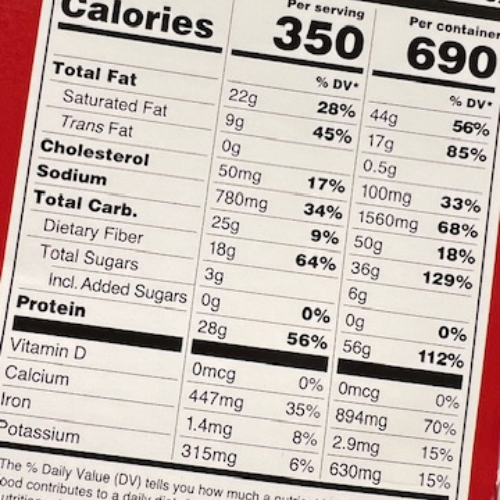Let’s dive into a crucial aspect of making informed decisions about what you eat—how to read and understand food labels.
Labels have become misleading and confusing but understanding how to navigate the information on packaging can be a game-changer in making healthier choices for you and your family.
Here’s your guide to decoding food labels:
1. Serving Size Awareness:
Pay close attention to the serving size, as all nutritional information on the label is based on this quantity. Compare it to the amount you typically consume. For example, a typical pasta box label will have you believe that it serves 8. I don’t know about you, but when I make a box, it serves more like 4. And don’t get me started on the serving sizes they list for tortilla chips!
2. Check the Ingredients List:
Ingredients are listed in descending order by weight. Choose products with whole, recognizable ingredients, and be wary of long lists with unfamiliar additives. Would your grandma understand each and every ingredient? If yes, you’re likely good to go. If she doesn’t know what it is, it’s likely not a whole food. A common mistake is to purchase something because it’s say, low in sugar, but are you trading that off for ingredients that contain neurotoxins, when it would have been more beneficial to toss a piece of meat in to a pan and get your protein that way?
3. Understand Nutrient Values:
Be aware of the key nutrients—such as calories, fats, sugars, and sodium—especially in relation to your dietary goals. Check the % Daily Value to understand how the product fits into your overall diet. Maybe you’re looking to increase your protein, but you don’t want to pick a product that’s high in protein but also high in sodium, particularly if you have blood pressure issues.
4. Identify Added Sugars and Artificial Sweeteners:
Look for hidden sugars and sweeteners in the ingredients list. These can go by various names, including sucrose, high fructose corn syrup, dextrose, lactose, sorbitol, malitol, saccharin, aspartame, neotame, acesulfame potassium and many more. The higher they are on the ingredients list, the higher the percentage of sugar in that product.
5. Watch for Allergens:
Food labels must disclose common allergens like nuts, soy, wheat, and dairy. If you have allergies or intolerances, scrutinize these sections.
6. Nutrient Claims and Buzzwords:
Be cautious of terms like “low-fat,” “organic,” or “natural.” Marketers freely use these terms and particularly for the word “natural”, it doesn’t mean a thing. Rubber is natural and so is petroleum, but it doesn’t mean you should consume it! Always check the nutritional information for the full picture.
7. Be Mindful of Marketing:
Packaging may feature health claims or endorsements. Many use the color green to trick you in to thinking something is organic. While some are legitimate, others can be misleading. Rely on the nutritional facts for accurate information. To bring this point home, check out Matt Rosenman on Instagram at @cheatdaydesign. He has the ability to rebrand any product to make it sound natural (think Skittles, Coca-Cola and Snickers as natural energy boosters, Twinkies as lean snacking, Lucky Charms as healthy oat puffs) – it’s highly entertaining and clearly brings the point home that literally anything can be marketed to sound natural and beneficial).
8. Compare Similar Products:
When choosing between brands, compare labels for nutritional content. This can help you make a more informed decision based on your health goals.

And if you really want to understand the value of what you’re putting into your body and want to do a test, buy a packet of La Banderita tortillas the next time you’re at the store and place the bag of tortillas in your pantry – my assistant mentioned that she bought a packet in August last year; the expiration date was November. Several months later, they still look totally fresh – not a trace of mold or anything else. There’s more than a little something wrong with that picture!
If you try this, let me know – I’m intrigued to know how long these will last before they start showing any signs of decay. For people who eat these regularly – imagine what it’s doing to their bodies!

